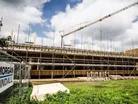Work Completes On Innovative Timber Frame at UEA Low Carbon Enterprise Centre

The team behind The Enterprise Centre at The University of East Anglia has reached another key construction milestone with the completion of the building’s ground-breaking timber frame.
The scheme, which is being managed by the Adapt Low Carbon Group and delivered by principal contractor Morgan Sindall, is leading the way in low carbon construction, with innovative processes being incorporated into every element of the project.
The structural frame was constructed by Cygnum and made with timber sourced from local Thetford Forest. The Morgan Sindall project team collaborated with Cygnum, The Forestry Commission and Thomson Saw Mills to take lumber that isn’t generally used for timber frame construction and use it to compose some of the structural elements of the building.
Gavin Napper, Area Director for Morgan Sindall said: “People have generally shied away from using local timber in construction, doubting its suitability as a construction material. We wanted to challenge that perception and tap into the great resources which are available locally.
“Due to the area’s climate and soil conditions, timber sourced from East Anglia tends to be fast growing Corsican Pine, which has a number of characteristics that make it more challenging than timber sourced from further afield and so does not lend itself as easily to this type of structural frame. However, our team was committed to using local timber and so we conducted extensive research, which enabled us to sort, condition and grade the Thetford timber which we used to construct the building’s frame.”
Once the timber had been sourced from Thetford Forest, located just 30 miles from the Enterprise Centre site, it was processed and sawn locally in Thomson Saw Mills, north of Norwich. The timber was then sent to Ireland, as local kilns were unable to meet the drying regimes necessary to bring the timber to the required moisture content. There it was kiln dried, planed and strength graded to meet the structural engineer’s pre-determined requirements.
John French, CEO of the Adapt Low Carbon Group, said: “Sustainability means using local resources and building high value supply chains from natural resources like forestry. This reduces carbon and creates high value jobs just as countries in Scandinavia have done. I am confident that the Enterprise Centre will stand up as a beacon of innovation that the enterprising businesses can now follow.
“Many people have talked a lot about using Thetford Forest timber in the built environment - we launched the idea at Ecobuild in 2010. I am proud that my team on this project have delivered it for the first time and so quickly, and proved it to be possible. It is a credit to our collaborative team, UEA, and to our contractors Morgan Sindall and sub-contractors Cygnum, that this is now happening.”
Gavin Napper added: “The successful use of UK timber in the Enterprise Centre could have a positive impact on the wider industry’s uptake of local timber. We’ve shown that lumber which is normally used for much simpler purposes like fence posts and pallets can play a much more significant role in the structural life of a construction project.
“As the project completes, we’re keen to highlight where there are inefficiencies in the processing of local timber into structural elements. With the help of our customers we want to ensure that these inefficiencies are challenged and overcome so that future construction projects can make better use of local timber. The more we demand the use of local timber in our projects, the more efficient suppliers will become, making the use of local timber more realistic, affordable and desirable. The completion of the timber frame marks a key milestone in the construction of the low carbon building and we are delighted with the progress that is being made on The Enterprise Centre.”
The Enterprise Centre project is an Exemplar Low Carbon Building, targeting BREEAM (Building Research Establishment Environmental Assessment Method) Outstanding and Passivhaus Certification (the global standard for energy efficient, low-carbon buildings). The timber frame exemplifies the responsible sourcing of materials and sustainable procurement, which will contribute to its BREEAM rating.
John Desmond, Managing Director at Cygnum, said: “The locally-sourced timber from Thetford Forest is not normally used in construction, so to use it for such a high quality structural application is quite an achievement. It’s a perfect fit for a project which in terms of sustainability and the ethos of the building is probably the most exciting building we’ve worked on in our history.”
The centre has been created to achieve a 100-year design life and aspects of the development will be constructed using traditional methods and locally sourced materials. Thetford timber, Norfolk straw and heather will be used, while various elements of the building will be thatched.



